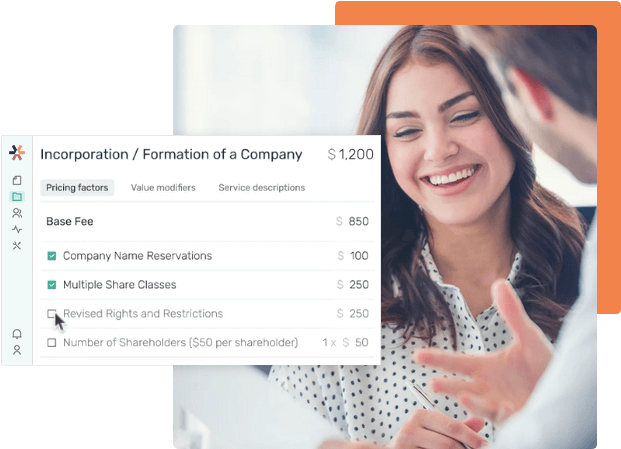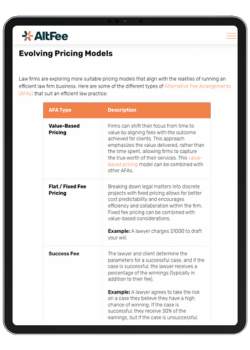Perhaps there is no task more irritating for lawyers than having to track time. Billing by the hour, and therefore the need to painstakingly track every productive minute is something that most lawyers are (unfortunately) intimately familiar with. Some legal timekeeping software offerings even track when a lawyer is idle, encouraging them to resume working—yikes!

There’s two conversations that converge when we’re discussing time tracking software for lawyers:
- The billable hour
- Pricing structures that offer a final price in advance of a legal service, often referred to as alternative fee arrangements (AFAs)
First, there’s the conversation about the billable hour or a billable hours law firm. The idea of billing by the hour for services isn’t exactly a ground-breaking concept, it’s something that has been standard across industries for some time, especially with mechanics and self-care-related services like masseuses, hairdressers, and estheticians. These are all examples of professionals that are known to charge by the hour for their services.
For legal services in the United States, the billable hour was born out of an attempt to increase attorney incomes and avoid “price-fixing” of legal service fees.
The problem was that if a client wanted a simple, straightforward service, like, say, a title search for a house purchase, minimum fee schedules for each legal service managed by state bar associations forced lawyers to charge at least that minimum fee or face disciplinary action. This didn’t match the value to the service provided and forced law firms and lawyers to charge more than they perhaps would want to for their services. Demand from clients for change meant that the minimum fee schedule soon became a thing of the past.
Thus, the billable hour was born—it’s easy to explain (lawyer charges for total time spent on a matter) and if a service is simple, theoretically, a client would end up paying less compared to the previously set out minimum fee schedule.
But, as lawyers today know, the billable hour has ended up suffering from the same problem as the minimum fee schedules of the past, plus a ton more issues—not only is it tougher to match value to service when you bill by the hour, lawyers are also now burdened with tracking their time, and price uncertainty with the billable hour pushes clients away rather than attracts them.
Which brings about the second conversation about AFAs. The idea with alternative fee arrangements is to more accurately match the legal service deliverable to value but also to reduce the time tracking burden on lawyers. Legal services can be priced in advance using a combination of experience, collaboration with other legal professionals, and other research like market rates to provide a fair price that works for the client and lawyer.
But the legal industry hasn’t been known for its ability to embrace change, and some law firms have resisted switching to AFAs, even though the number of firms using AFAs continue to increase every year.
One of the main negative elements of the billable hour is timekeeping. So time tracking software for lawyers was developed to make it easier for legal professionals to track time accurately and make billing by the hour easier. Or at least, that’s the theory.
But before we get into that, let’s take a step back and define what legal timekeeping software is, how it typically works, its pros and cons, and of course, the big finale: how legal timekeeping software works with alternative pricing solutions.
What is Legal Timekeeping Software?
Simply put, law firm time tracking software lets lawyers and legal professionals track their time digitally. In many cases, attorney timekeeping software works on both desktop and mobile, meaning busy lawyers can keep track of their time even if they are away from their computer. The other goal of law firm time tracking software is to make law firm billing easier, by automatically using the tracked time spent on a matter to create a final invoice for the client.
But just because legal timekeeping software is digital doesn’t necessarily mean everything is automatic. Depending on the lawyer time tracking app, a professional may still have to manually start and stop a digital timer—meaning they don’t have to manually count the minutes that pass, sure, but also that they have to remember to start and stop the timer in the first place.
Other legal time lawyer timekeeping software offers automations that reconstruct how much time went into a project by analyzing work performed, emails, call logs, instant messages, SMS texts, calendars, and more and putting together the total time spent like a puzzle. However, it’s important to note that in-person conversations, pen-to-paper note-taking, or other non-computer activities aren’t counted so the final puzzle might be missing a few pieces.
Basically, there’s a wide number of ways that legal professionals can use law time tracking software to their advantage, and what they need often depends on things like workload and the attorney time keeping software’s compatibility with the other software in the law firm’s tech stack.
4 Ways to Track Your Time with Timekeeping Software for Attorneys

We’ve teased a few ways that legal professionals can use lawyer timekeeping software, so let’s get into some more specifics about all the different ways you can use this software to track time.
Software Stopwatch
Using law firm time tracking software that simply has a start and stop button to track time may be easy to use, but comes with a high level of discipline to ensure it’s used consistently. Sure, it’s straightforward to tell lawyers that they have to remember to start the clock before working on a project, but in practice? It’s likely that they’ll forget, especially if they’re busy. A software stopwatch may seem like an easy solution on the surface, but the results are going to vary.
Log Entries Manually After the Fact
Logging entries using law time tracking software seems like a good solution, but like the software stopwatch, relies on the legal professional remembering to do it. As you can imagine, the longer someone waits to enter the time spent on a project, the less accurate it will be. There are lawyer time tracking tips like making a to-do list and blocking out time during the day to record time, but of course, this all takes away from time spent practicing the law and adds to a lawyer’s already administrative-task-filled schedule.
Log time From Calendar Entries, Communications, and Work Performed
We mentioned earlier that there’s lawyer timekeeping software out there that will aggregate communications, applications, and more to determine how much time was spent on a project. This includes:
- calendar entries
- work performed (time spent in a word processor, spreadsheet, knowledge management software, pricing software, or other application related to the project
- client communications like call logs, emails, text messages, etc.
This is probably the most accurate way to track time spent on a project, but it’s also the least forgiving as it only tracks “productive” time. Those few minutes a lawyer takes to make a coffee or use the restroom obviously wouldn’t count as billed time, but a chat with a colleague in-person about the case would absolutely count as billable time and isn’t recorded automatically. This means that the digital logs need to be adjusted manually to account for this time, taking away from the effectiveness of the software's automatic time logging capabilities.
Further, if the time tracking software for lawyers is meant to analyze emails, call logs and other information to construct the total time spent, then that information needs to be accessible to it. If connectivity with all these sources isn’t possible or is out of scope in terms of making it possible, then it's not a viable option for the firm.
Billable Hours Chart
Lawyers tracking their time in 6-minute increments isn’t exactly unusual but seems ridiculous in terms of actual execution. The billable hours chart attempts to reduce the pain and make calculations easier by providing time increment translations for total minutes spent on a task. Here’s an example chart that uses increments of 1/10th of an hour.
|
Time increment
|
Minutes
|
|
0.1
|
1-6
|
|
0.2
|
7-12
|
|
0.3
|
13-18
|
|
0.4
|
19-24
|
|
0.5
|
25-30
|
|
0.6
|
31-36
|
|
0.7
|
37-42
|
|
0.8
|
43-48
|
|
0.9
|
49-54
|
|
1.0
|
55-60
|
Let’s break that down further:
if a lawyer’s hourly rate is $200/hr, and they spent 15 minutes on a task, they could quickly look at the chart and determine that they’d charge 0.3 of an hour for the work.
If you multiply that by the hourly rate, you get a result of $60.
So the calculation would be:
Hourly Rate x Time Spent = $Total
Manual Time Logs (Spreadsheets, Word Processors)
Tracking time manually is the obvious alternative to legal timekeeping software. Spreadsheets and word processors provide an easy and straightforward way to track time that pretty much everyone can understand, especially if they’re just filling in a template. If it’s a small law firm with few clients, then this will likely be a doable solution, at least for the short term.
But the reality is that demand for legal services is increasing, and thus even smaller law firms are bound to see more clients than usual, even if the plan isn’t to scale. According to Clio’s 2022 Legal Trends Report, new casework has been increasing since 2020, meaning lawyers are taking on more work than ever before. More clients equals more complexity with tracking time manually, and even small law firms are likely to see a quick uptick in work, making accurate manual time tracking difficult.
Next, let’s look at the pros and cons of legal timekeeping software in general and why legal time entry can be so challenging for lawyers and law firms.
Start Earning More Revenue with Fixed Fees
Break free from hourly pricing and take the fear out of scoping and pricing client projects to start maximizing profitability.
Book A DemoPros and Cons of Law Firm Time Tracking Software

|
Pros
|
Cons
|
|
Automatically tracks time once activated
|
Often requires manual start and stop to accurately track time (unless using an aggregated time tracker)
|
|
Makes it much easier to track time versus doing so manually
|
May not be 100% accurate due to human error (e.g., forgetting to start or stop timer, forgetting to switch matters or tasks, etc.)
|
|
Holds legal professionals accountable in terms of how they are spending their time at work
|
Billable hour goals may cause legal professionals to work less efficiently in order to meet or exceed billable hour targets set by the firm
|
|
Can be used for law firms that still use the billable hour, as well as law firms that use AFAs
|
Tends to lean more toward the traditional billable hour with how tracked time is handled with regards to automated invoicing and other features rather than being accommodating for AFAs
|
|
Provides analytics that gives an objective look at efficiency and productivity, and can help influence future pricing strategies
|
Pricing based entirely on time spent doesn’t effectively marry value of service with cost and may be prone to manipulation by legal professionals to meet billable hour requirements, deadlines, etc.
|
|
Helps to hold legal professionals accountable for their time
|
Time doesn’t paint the entire picture of how a task was completed or what hurdles presented themselves, meaning that it can’t be relied on as the only metric for accountability
|
Why is Legal Time Entry so Challenging?
Do you remember everything you did last week, or even yesterday?
It’s not unusual for someone to forget what they did yesterday or the day before, especially when it’s a busy day. Sometimes, people forget what they did in the morning by the afternoon. Imagine dealing with client after client as soon as you log on to your computer for the day or enter the office and not getting a chance to stop until the afternoon. Trying to reconstruct each task and how much time each one took for each client will likely result in scratching your head in confusion.
Even with attorney time tracking software, it’s next to impossible to give a 100% accurate account of how much time a legal task took unless you’re super diligent with manually keeping track of everything as you go. Legal timekeeping software still has a manual aspect you can’t get away from, which is having to start and stop it at the appropriate times (i.e. when starting or stopping a project or switching to a different one). Even lawyer timekeeping software that aggregates emails, call logs, and other communications to determine time spent can’t always paint an accurate picture—research, note-taking, and other actions that aren’t easily measured by time can affect accuracy, leading to the need for review and adjustments after the fact.
Best practice for legal professionals is to track their time at least daily, but preferably throughout the day, probably using a combination of software and manual recording, and the more frequently, the better. Even small tasks like quickly answering a text or email have to be recorded in order to keep the time tracking as accurate as possible. It’s unreasonable to expect anyone to track their time that granularly, but time tracking for lawyers in 6-minute increments isn’t unheard of—in fact, it’s pretty much standard practice for most law firms that bill by the hour.
This highlights the biggest issue with legal time tracking—accuracy.
Lack of accuracy with time tracking leads to one of two issues:
- Overbilling clients for time spent on a legal matter
- Underbilling clients for time spent on a legal matter
When over or underbilling happens, it directly affects your law firm’s bottom line. Overbilling might seem like the preferable option, but you’re potentially sacrificing client trust and their perception of value for your firm's legal services. In other words, if a client feels like they’ve been cheated because of a big bill, it’s not doing your firm any favors.
Overbilling can also lead to other client issues, like having to offer discounts to appease a client who feels their bill is too much for the services rendered, or worse, having to send a client to collections due to an unpaid bill. Nobody wants to have to resort to these things to get paid, but it can be the reality for law firms still relying on straight time tracking to bill clients.
How Legal Timekeeping Software Works With Alternative Pricing Solutions
You may think that if a law firm isn’t using the billable hour and has instead implemented alternative pricing structures for its legal services, it wouldn't need time tracking software for attorneys. While timekeeping in general is less of a focus, ensuring that projects are completed in a timely manner is still pertinent to ensure that time is spent as efficiently as possible and that profit can still be generated from work performed. Therefore, time tracking is still considered important to many firms that predominantly bill using AFAs, even if it is only used as a performance tracking metric.
However, most time tracking software for law firms was built with law firms that bill by the hour in mind, meaning that some of the features may not be useful for a law firm that uses AFAs.
|
Legal timekeeping software feature
|
Compatibility with AFAs
|
|
Aggregating communications (emails, call logs, texts, calendars, etc.) to determine time spent on a project
|
- Can be useful for determining the total time and workload that went into a project to help inform future pricing adjustments
- Can be useful for determining how many stakeholders were involved in a project from start to finish
|
|
Detailed time reports and analytics
|
- Helps with legal professional accountability
- See which tasks take up the majority of time for a legal professional or the law firm as a whole
- Helps determine scheduling, project management, and more
|
|
Using tracked time to automatically create an invoice
|
- Since AFA billing isn’t based on tracked time (from the client’s perspective) then this feature won’t work with AFAs
|
With alternative pricing structures, attorney time tracking software can still be used, but in a different way. Rather than relying on law firm timekeeping software to paint the entire picture of task completion using straight time, it can be used in addition to pricing software like AltFee as just another tool to determine the best pricing for legal services.
AltFee is collaborative legal pricing software that allows firms using AFAs to accurately scope and price their services. When a law firm uses AFAs, they need to consider a variety of factors to set the price of a legal matter, including but not limited to:
- Overall complexity of the matter (e.g., expertise and research required)
- Number of legal professionals needed to work on the matter
- Approximate time needed to complete the matter
Using attorney time tracking software can be a useful tool for determining how long a project typically takes to complete, and alongside other factors, whether adjustments need to be made in terms of how a legal matter is priced.
Any relevant updates to pricing as a result of time tracking data can be recorded in AltFee, whether for a specific legal matter or to use for future matters of the same type. In this way, matter pricing within AltFee can be continually optimized over time.
Additionally, tracking attorney time can be a very useful management tool for law firm leadership. Time tracking is necessary to determine an attorney’s realization rate on a specific project; firm management can look at which projects yield the highest realization rates (which work was completed most efficiently) and make those particular project types an area of practice focus.
Conclusion
There’s no doubt that watching the clock can be nerve-wracking for legal professionals. The original function of lawyer time tracking software was to make billing by the hour more accurate by making it easier for lawyers to track their time. The unfortunate reality is that although in some ways it has absolutely made time tracking easier, it has also led to things like:
- Manipulation of hours
- More stress on lawyers to meet billable hour requirements and deadlines
- Inaccurate final time sheets
In an industry where lawyer burnout is a very real issue affecting not only lawyers within the industry itself but also potential newcomers, it’s clear that any positive change that takes some of the pressure off should be strongly considered. In this case, reducing the focus on tracked time and its relationship to billing is a good step forward.
One of the ways that this can be accomplished is through alternative fee arrangements. Using AFAs, law firms can not only provide more client-centric service, but they can also more accurately convey the value of every legal service that they provide to their clients. Lawyers can do better work without the stress of billable hour requirements hanging over their heads. Clients ultimately feel better about legal services because they have price certainty and a high perception of value from the beginning.
By using AltFee’s legal matter pricing system, law firms won’t be starting from scratch either; they can utilize AltFee’s pricing template database of 450+ templates to kickstart their matter pricing. Matter pricing templates are organized via project categories and can be customized and adjusted for specific clients as needed. Legal professionals can also customize the templates as needed to better suit the needs of the firm and the way in which they price their matters.
This leads to an alignment of interests for all involved stakeholders and better attorney client relations which ultimately contributes to a better outlook for the legal industry.
Interested in learning more about AltFee’s pricing software? Get a demo today!
Start Earning More Revenue with Fixed Fees
Break free from hourly pricing and take the fear out of scoping and pricing client projects to start maximizing profitability.
Book A Demo










